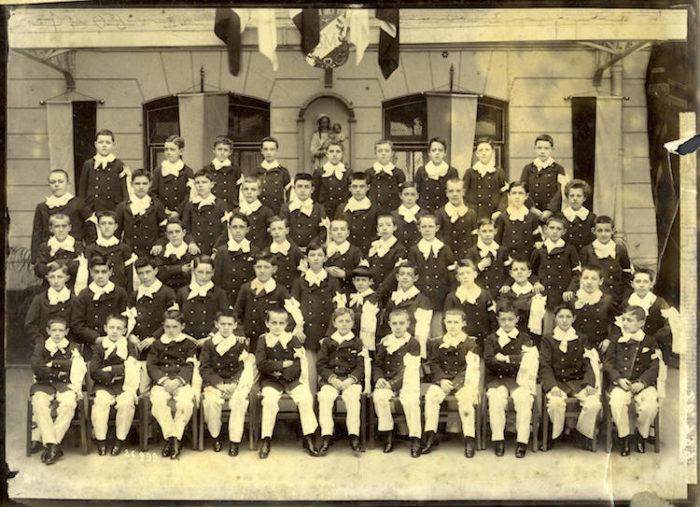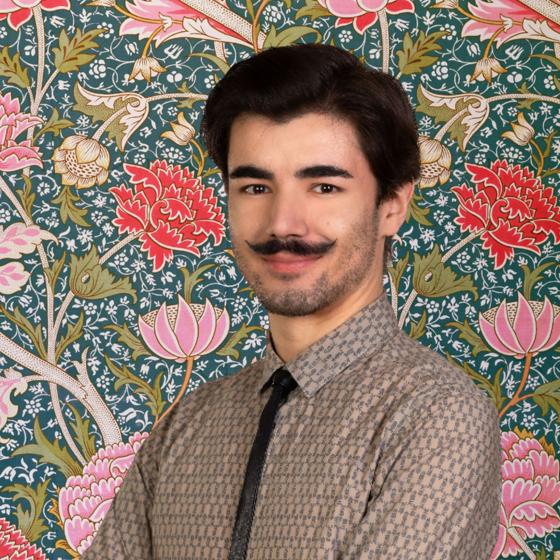Chinos, cargo pants, elephant legs, skinny jeans, slim, jeans, baggies… pants , whatever their shape, are now a must-have in the male wardrobe.
However, this status is very recent in the scale of the history of fashions: this garment, as we know it today, is barely two hundred years old. It might seem old but this antiquity is quite relative when we consider that men hid their thighs, even their legs, under tunics and dresses from Antiquity to the 14th century, before wearing breeches for more than four hundred years.
Like all items in our wardrobes, pants have a history and their near-universality did not become so overnight. When we mechanically put them on every day, we don't think about the barriers they had to break down to parade on our legs from morning to night.
1. Antique breeches and Ancien Régime breeches: trousers in the making
Its most distant ancestors are the braies, which our collective imagination today associates with the Gauls, as the Romans already did in their time. .

Colored engraving made from the Monument to Vercingetorix by Aimé Millet (1865). Epinal image of the Gaul, under his tunic we can see his breeches, tightened at the legs by strips of fabric (fashion attested in any case a little later, in the 9th century).
They were derived from the clothing of the Celtic and Germanic peoples who found them practical for insulating their legs from the cold, especially when traveling on horseback. While clergymen and powerful people adopted the toga and its avatars, the breeches survived it and resisted the Romanization of society. They consisted of two legs joined by a simple seam and it is in these that our contemporary trousers found the first of their characteristics: their bifid appearance.
However, unlike these, only the lower part was visible. They were in fact worn with a tunic falling on the thighs, which led to the medieval bliaud, a dress worn by men and women from the 11th to the 13th century, then to the cotte and the surcoat, even longer.
It was only in the middle of the 14th century that clothing, by becoming shorter, revealed the junction between the legs and the bust, giving the male silhouette the general appearance that we know today.

Dedication of the historical Bible of Jean de Vaudetar, Paris, 1372. King Charles V still wears the robe, Jean de Vaudetar a doublet revealing his breeches. (Copyright Wha United Archives)
Around 1330, wealthy young men adopted the doublet, a sort of high waistcoat with long sleeves, falling down to the hips and revealing the breeches. These, short under the Gauls, became longer as the breeches became shorter and were transformed into simple underwear. Tight-fitting, they reveal the shape of the thighs and, scandalously, mold the buttocks and crotch.
In the 15th century, the beginnings of breeches covering this area appeared. Worn in different forms in the 16th and 17th centuries (breeches, gregues, rhingraves, etc.), we can see avatars of the breeches characteristic of the Ancien Régime.

Attributed to François Clouet, portrait of Henry II, circa 1550. The king wears a doublet over padded hose (gregues). The fashion demanded a prominent false and padded codpiece (Credit Active Museum Collection)
2. From underwear to outerwear: the emergence of modern trousers
In 1789, the essential garment to cover one's legs was thus very bifid, tight at the waist, but it was short: it still had to find the length of the original breeches, from breeches to become trousers. If we no longer speak of breeches to designate this long garment with two legs, it is because it was (re)introduced in France by the Venetians and their theater accompanied by another name.
In the Commedia dell'arte, the character of the old man, Pantalone, was always dressed in long underpants, which took their name from our side of the Alps. For a long time, the trousers remained associated for people of the world with this garment originally worn underneath. In 1768, Louis-Antoine de Caraccioli, in his Dictionnaire critique, pittoresque et sententieux, described them as a "kind of underpants that hold with stockings", and we can understand that they were worn under the breeches.
The common people wore it as outerwear. The fitted breeches required the know-how of a craftsman while the trousers were of a primitive enough form to be easily sewn at home . Their length made them more protective and meant that they were still often referred to as "long breeches", the term trousers only really becoming established in the 19th century.
In the upper classes, it was little boys who, at the end of the 18th century, were the first to adopt trousers as outerwear. These were part of a costume called "à la matelote", then very fashionable and, as its name suggests, inspired by the sailor's costume. At a time when thinkers such as Rousseau were interested in the healthy development and singularity of the child, this garment was undoubtedly seen as a way of freeing the movements of youth. .

Louise-Elisabeth Vigée Lebrun, portrait of Queen Marie-Antoinette surrounded by her children (1787). The dauphin Louis-Joseph wears a costume called "à la matelote".
These children's trousers are also related to the English notion of "comfort", which was then spreading in France, affected by a real Anglomania which also influenced the costume of adults. Before the Revolution, some elegant men already wore trousers, tight-fitting on the other hand, more comfortable for riding than breeches.
These also have the advantage of providing a solution to the fears of several hygienists, including Doctor Macquart who alerted his contemporaries in 1798 about the garters of the breeches; according to him, they prevented good circulation of the blood and the movements of the leg muscles.
It is for this same reason that European infantrymen saw their breeches replaced by long trousers from the 18th century, but especially in the 19th century, which would then influence civilian fashions, sensitive to the prestige of the uniform.
3. From the legs of the Sans-Culottes to those of the aristocrats: the conquests of trousers
It is often thought that it was the "Sans-Culottes" of the French Revolution who replaced this aristocratic garment with the trousers of the people. They undoubtedly had a role to play in this story, but not as major as we have wanted to believe.
Their image was immortalized by the actor Chenard, portrayed by the painter Boilly, dressed as the ideal Sans-Culotte during the festival in honor of the freedom of Savoy, on October 14, 1792. Next to this Epinal image of the revolutionary in clogs dressed in trousers and a carmagnole , the portraits of the high priests of the Revolution (Robespierre, Danton, etc.), show that they never gave up their powder or their breeches, which were also worn by all the deputies of the Third Estate at the Estates-General of 1789.

Jean Baptiste Lesueur, “Liberty or Death”, circa 1790. In the foreground a “Sans-Culotte” wears trousers and a carmagnole next to a man in a tailcoat and breeches (Photo Josse Christophe)
And if, as Christine Bard tells us in her book Une histoire politique du pantalon (Seuil, 2010), Saint-Just, the "Angel of Terror", owned two pairs of breeches and two pairs of trousers when he died in 1794, we can assume that these must have looked much more like the English tights and therefore fashionable, than those of the Sans-Culottes, shapeless and still too popular, patriotic as they were.
It was only at the beginning of the 19th century, when an era of freedom of dress began, that breeches began to be seriously competed with trousers. During the day, they were narrow, inherited from the English trousers of the previous century, or wide and straight, as those of the Sans-Culottes were; worn with fine shoes or patent leather boots, they lost their popular side.

Journal des Dames et des Modes, “Costume parisien” n°1153, 1811: model of trousers for walking. (Credit Collection IM KHARBINE TAPABOR)
In the evening, it can be worn tight, with pumps, flat and open shoes. However, it does not immediately meet with unanimous approval, as Horace-Napoléon Raisson reminds us in 1829 in his Code de la Toilette: "The fashion for breeches, which for some years now we have tried in vain to abolish, will probably continue for a long time to come in good company; it is in fact more elegant, much more suitable than that of trousers which we want to replace it."

Journal des Dames et des Modes, “Costume parisien” n°1469, 1815: model of tight trousers for horse riding (Credit IM KHARBINE TAPABOR Collection)
The author acknowledges, however, that the trousers, in addition to being "favorable to maintaining health", are "convenient and elegant in undress" From this time onwards, breeches became increasingly rare. In everyday life, they ended up being kept only by gentlemen old enough to have played backgammon with Marie-Antoinette, and by liveried valets.
It continued to be worn at court by men who were received there for official ceremonies until the end of the reign of Napoleon III in 1870, and remained an essential element of the festive costume of several "countries of France", in Brittany and Alsace for example.
During the Belle Epoque, breeches found favor again in the eyes of a few aesthetes, like Oscar Wilde who wore them every day in the 1880s, in a dandy spirit. Their return was also supported by hygienists who believed that the open trousers did not sufficiently insulate the legs from the cold air.
4. From the 20th century to the present day: the almost unchallenged reign of trousers
In the first half of the 20th century, while some sportsmen adopted derivatives of them, such as the knickerbocker, only little boys remained in short pants in the city until they entered middle school or even high school. The first long pants, for adults, were those worn at communion since the 19th century. .

Group photograph of communicants, circa 1910. (Credit: KHARBINE TAPABOR Collection)
Today, it is becoming increasingly rare and only the boy scouts and a few old families seem to continue to defend this terrain on which trousers are making irremediable progress and no longer really have any competitors.
We certainly wear shorts and Bermuda shorts, but in terms of cut, they are just a shortened version. As for the men's skirt, promoted by great designers such as Jean-Paul Gaultier, it is an epiphenomenon. After more than a thousand years of changing fashions and mentalities, trousers have managed to establish themselves in the men's wardrobe for all circumstances, and have even, in parallel, managed to make their way into the women's wardrobe.
But that's another story. .




